Awareness
The Science of Aji-no-moto
Tharosa Missaka Rajaratne
Published on Thu, 04/30/2020 - 12:22

Photo by Mgg Vitchakorn on Unsplash
Introduction
Commonly called food myths such as “chocolate is an aphrodisiac”, “garlic induces fever when kept under one’s armpit” and many other are heard from every corner of the world since the beginning of the human order. But along with scientific advancement, human kind learned to scientifically explain some of these phenomena. However, controversies prevail among the commoner either due to extreme social beliefs or complexity of scientific explanations to those phenomena. Extreme social beliefs are often caused by hoaxes which pass down from generations. For instance, many Sri Lankans tend to believe that and foreign foodstuffs are unhealthy and thus their consumption causes cancer, infertility, and bone decay etc. Most of these beliefs lack scientific evidence or explanations and are strictly based on either hypothetical or isolated incidents which everyone claims as “thus have I heard”. Monosodium glutamate (MSG), better known as 'Aji-no-moto', has tremendously, confronted with discussed culinary myths. Unlike other countries do, Sri Lanka generally perceives completely different beliefs about MSG. In the recent past, MSG gained attention in Sri Lankan media after revelation of alleged usage of it as an effective substitute to the notorious herbicide Glyphosate which was banned from importing. This raised alarm in the country that MSG is not only carcinogenic, as previously claimed, but also is extremely toxic and thus it causes bone decay, cancer etc. This social perception encouraged examination of scientific literature of MSG. This review thus intends to distinguish science from myths of MSG.
History of MSG and AJI-NO-MOTO
During the early 1900s, Kikunae Ikeda, a Professor of Chemistry at the Tokyo Imperial University of Japan, conducted a series of tests on a popular seaweed known as Kombu (Laminaria japonica), an ingredient of many Japanese cuisine, after noticing that whenever Kombu was assimilated with the Japanese broth Dashi it produces savory-like taste, which did not fit into any of the scientifically described basic tastes at that time: sweet, sour, salty, or bitter. Moreover, he learnt that the addition of Kombu would likely enhance the overall flavor of the broth, and thus named this new unknown class of flavor as “Umami”, which translates roughly into ‘savory’ in Japanese. This new class of flavor is now widely accepted as the fifth taste.
The flavor enhancing component was determined to be the Glutamate ion and was extracted as its Single Sodium salt Monosodium Glutamate (MSG). His aims were to extract the flavor-causing compound as a stable solid, and also to commercialize the process, which resulted in the establishment of the popular brand “Aji-no-moto” (味の素) in 1917. The word Aji-no-moto gives a compound meaning derived from each Chinese character: Aji – Taste, no – of, Moto – Essence. And so the literal meaning is “essence of taste.” Yet the contextual meaning of Moto also refers to refining and enhancing. Therefore, the meaning of Aji-no-moto could also be identified as “Refiner of Taste” or “Taste Refiner.” Starting from a production of mere 4.7 tons in Japan in 1910 and continuously increasing into multi-million ton, multinational production of MSG as of now since the establishment, Ajinomoto Co. has secured themselves as the tycoon in the MSG industry and acquired an undisputed monopoly in branding to the extent that MSG to be colloquially recognized as Ajinomoto among the commoner. Three methods have been employed to produce MSG throughout its history; Hydrolysis of vegetable proteins with Hydrochloric Acid (1909-1962), Chemical Synthesis with acrylonitrile (1962-1973), and Bacterial Fermentation (Current Method). The fermentation process is much similar to that of any other ordinary yogurt or vinegar making method and the ingredients used are generally tapioca, sugar beets, sugar cane, and molasses. Upon the production of MSG in a commercially feasible stage, MSG was available to be purchased conveniently, more than ever and was used extensively in the East and South Eastern cuisines like Chinese, Korean, and Japanese.
MSG and Chinese restaurant syndrome
The inception of social discontent towards the usage of MSG emerged in 1968, after a paper was published in the New England Journal of Medicine by Robert Ho Man Kwok in which he described a list of symptoms he experienced after eating at Chinese Restaurants. His symptoms included “numbness at the back of the neck, gradually radiating to both arms and the back, general weakness and palpitation” (Kwok, 1968). Furthermore, he suggested various possible causes for the aforementioned symptoms, of which the usage of alcohol, salt, and MSG in cooking were prominent. Since the symptoms developed mainly via Chinese restaurants, the author coined the complex of symptoms as Chinese Restaurant Syndrome (CRS). Since then, numerous self-limited and isolated incidents relating to CRS started to appear in the society alongside Kwok’s paper, and MSG was mainly focused and often blamed to be the cause of CRS.
The list of symptoms has since then been updated adding to it more symptoms such as headache, flushing, muscle tightness, and asthma attacks etc. The scientists have been conducting an array of tests to verify the role of MSG as a causative of CRS but they have made no conceivable explanation so far. Sodium Glutamate: A Safety Assessment (Food Standards Australia New Zealand, 2003) is a scientific assessment report that presents in-depth analyses of Kinetic and metabolic activity of MSG and scientific reviews of previously conducted experiments on MSG and CRS. These tests have been conducted as double blind placebo controlled experiments (DBPC) to minimize experimental bias since most of the participants were self-identified as MSG sensitive. Notable studies of this sort include Tarasoff and Kelly (1993), Yang et al (1997), and Geha et al (2000). Almost all the studies have failed to show any broad statistical correlation of MSG as CRS causative because many participants failed to produce consistent observations (symptoms) to each relevant test (the MSG containing test), showing that the MSG is very unlikely to have a correlation with CRS symptoms among the participants. It also should be noted that while the average consumption of MSG in the United Kingdom is 0.59 g/day and extreme consumption (Consumers of the 97.5th percentile) is 2.33 g/day (United Kingdom - Rhodes et al, 1991)), some of these tests conducted have administered extreme doses of MSG such as 6 g (Altman et al, 1994), 7.6 g (Germano et al, 1991), 18.5 g (Wilkin, 1986), 147.0 g (Bazzano et al, 1970) per day to the participants, which are very unlikely to be have ingested in practical customary levels even at extreme occasions, have shown that the symptoms were irreproducible with consistency.
By taking into consideration of the results of double blind tests and other toxicological studies, the Joint FAO/WHO Expert Committee on Food Additives (JECFA) in 1988, European Community’s Scientific Committee for Foods in 1991, the Federation of American Societies for Experimental Biology (FASEB) in 1995 (reaffirmation of 1959 U.S Food and Drug Administration’s identification as ‘Generally Recognized as Safe’ – GRAS), and Food Standards Australia New Zealand (FSANZ) in 2003 concluded that MSG is a safe food additive. On a scientific note, the institutions concluded that MSG (inclusive of other glutamates): administered on rats, mice and dogs does not reveal any adverse effects in acute, sub-chronic, chronic periods under reproductive toxicity and teratology, fails to provoke the full spectrum of symptoms cited under CRS in humans, total dietary intake of glutamates does not present a hazard to health of the general population and any greater hazard to pregnant women and infants, a subgroup of presumably healthy individuals present symptoms of CRS when MSG is administered on an empty stomach.
Science of MSG
In spite of the social agitation regarding the use of glutamate flavoring in food intensified in the 20th century, via biological processes humans unknowingly consume glutamates daily from the very first moments of human life through breast feeding. From a historical culinary standpoint, records of consumption of processed foods which contained glutamate flavorings dates back to 5500 BC, with the early cheese production process. Glutamic acid is an important amino acid which is found almost in all plant and animal cells and their products as a constituent bound to proteins (protein glutamates). However, only the glutamates which are unbounded to proteins (free glutamates) cause flavor enhancement, which accounts for a fraction of the total glutamate content. The abundance ratio between the two kinds causes some natural foods to conceal the total glutamate content. As an example, 100 g of corn contains an average of 1765 mg of bound glutamate and only 130 mg of free glutamate, and 5583 mg and 200 mg respectively in peas, explain why the savory taste of the above foods is somewhat insignificant when consumed raw and unprocessed. But it also needs to be taken into consideration that the ratio is subject to change with cooking methods. Conversely, glutamates in foods such as Marmite (1960 mg), Japanese Fish Sauces (1383 mg), and Roquefort cheese (1280 mg) are present unbound thus in palatable form.
Apart from glutamates, compounds from another class namely ribonucleotides, were discovered to possess similar MSG properties. In 1913, ribonucelotide inosine monophosphate (IMP) was found in dried bonito flakes (dried and fermented Bonito fish) by Prof. Shintaro Kodama, a disciple of Prof. Ikeda, and in 1957 ribonucleotide guanosine monophosphate (GMP) was found in Shiitake Mushrooms by Akira Kuninaka. The latter’s discovery also revealed the synergistic property between ribonucleotides and glutamates, which would explain an important and popular culinary practice known as ‘food-pairing’. Whenever foods with considerable levels of glutamates are combined with ingredients having ribonucleotides, the resulting taste intensity would be elevated and ‘amplified’ in a mere multiplicative manner, rather than as if the individual intensities of each ingredient were combined additively. Some famous food-pairings around the world such as Dashi with Kombu and Japanese Bonito Flakes, Chicken soup with Chinese Leek and Chinese cabbage, Parmesan cheese on tomato sauce with mushrooms (Italian), can be explained by this synergistic effect.
The involvement of tomatoes in the culinary world has much to do with the aforementioned Bound to Unbound Glutamate ratio. Tomatoes have a naturally well-tolerated unbound to bound glutamate ratio of roughly 2:3, making it an excellent natural flavor enhancer which, ironically, people use unknowingly in many cuisines. A specific example from Sri Lankan cuisine is the addition of tomatoes in sprat curry, sambols and lunu-miris to elevate the overall savory flavor. Also, the extensive usage of tomatoes in a spectrum of dried fish, and mushroom curries for the same purpose can now be explained using the synergistic effect, as cured fish and mushrooms contain high levels of glutamates, IMP, and GMP. This method was broadly practiced and was considered as a popular ‘trick’ of the Sri Lanka cuisines of the yesteryear. In cuisines other than tomatoes and Kombu, there have been records of many ingredients used as flavor enhancers, which also were found to be containing Glutamates, IMP and GMP as major components. It is said that during the Roman Empire, the commoners have used a special flavor enhancing sauce named ‘Garum’ which was made by fermenting fish in seawater, as an inexpensive and successful substitute to the much expensive commodity salt, to ensure elevated levels of taste.
By considering the historical and scientific literature, it is obvious that Glutamates have been in association with humans (as well as animals) since the dawn of time and have not posed any adverse effect to the general population under acute or chronic periods. Even if such adverse effects existed among a very small percentage of the population (MSG hypersensitive individuals), no fatalities have been recorded upon ingestion of Glutamates as the symptoms often completely disappear within few hours at most. In contrast, of people who have developed intolerance to lactose, gluten, meat, or affected by autoimmune diseases such as Celiac Disease, are widespread among the general population and great attention to their food is always given as such intolerances and reactions would often cause severe and acute complications and sometimes death if left untreated immediately.
One of the most popular statements made about CRS in the social literature is “… (If MSG is bad for you) why doesn’t everyone in China have a headache?” - Jeffrey L. Steingarten. The statement, though delivers no scientific defense, delivers an ample amount of unsophisticated yet undeniable logic as China consumes Glutamate flavorings the most in fact, Chemical Economics Handbook: Monosodium Glutamate Report, 2015 published by IHS Markit reveals that in 2014, China has consumed 55% of the world annual MSG production of 3.2 million metric tons or 3.53 g per capita per day proving Glutamates as a flavor of the East. In contrast, the world consumption of MSG is 1.23 g per capita per day. Sri Lanka’s MSG consumption is nearly one quarter of the world consumption averages. Sri Lanka has imported 2740 metric tons of MSG in 2013 and this is equivalent to consumption of 0.36 g per capita daily. Yet Sri Lanka’s concern over MSG is far more extensive compared to the high MSG consumer countries and those who have scientifically investigated MSG.
To elaborate more on the statement with a scientific approach and on a broader population, the intake of Glutamic Acid and Glutamate in infants through breast milk can be considered. While the amino acid (Free and Total) contents in breast milk could vary per individual due to the nutritional status of the mother and the lactation stages etc. the relative abundance of each remains widely well established and Glutamic acid remains the most abundant, around 20 times more abundant than any other amino acid (Zhang, Adelman, Rai, Boettcher, & Lõnnerdal, 2013). On average, it has been calculated that in a 600 ml daily feed, a 4 kg infant would ingest around 19 mg/kg of Free Glutamates and 0.35 g/kg of Bound Glutamates (Agostoni et al, 2000; Jochum et al, 2006). This also shows that infants consume higher amounts of Free Glutamates per kg body weight than during their later life. Thus, if CRS accusations of foreign countries and cancerous charges of Sri Lankan community about Glutamates were in fact true, the humankind would have struggled to live past infancy.
One hypothesis of Prof. Ikeda made upon the discovery of Glutamates’ significant prevalence around and in proteins is that the flavor enhancing trait of Free Glutamates offers an appealing approach to humans to consume food containing proteins, since proteins are essential for human life and such essentiality is delivered at best effectiveness in an tempting manner. Similar biological adaptation is shown by both animals and humans towards poisonous or potentially harmful plants and animals by recognizing the alerting colors, pungent odors, and disapproving flavors, and through the course of time this behavior has been generalized among victims to avoid such undesirable encounters.
In addition to MSG’s controversies, interesting and important facts about MSG and its chemical properties would also be worth knowing. One important attribute of MSG is its inherent limitation in flavor enhancing. Although it is a flavor enhancer itself, it does not enhance the flavor indefinitely upon further addition to the food of interest once the optimum level has reached, and also sometimes the food would rapidly turn out to be undesirable. Another property is that MSG accounts for lower Sodium content by mass (12%), compared with table salt Sodium Chloride (39%). This makes MSG an ideal flavoring substitute for low-sodium needs. However, in Sri Lanka and especially in contemporary street food culture, these attributes are often overlooked and ill-treated. The famous ‘Aji-no-moto taste’ and immediate thirst experienced upon consuming street food (fried rice and Koththu etc.) could be explained by the excessive addition of MSG and salt together, since both additives contain Sodium and excess Sodium causes dehydration.
As per regulations imposed by various Food and Drug Authorities, packaged foods are mandatory to carry ingredients and additives listed clearly on the package. To meet with global standards and for convenience, Sri Lankan packaged foods often follow the ‘E Number’ system, which is a number code system for food additives approved within the European Union, when labeling food additives. Of the E Number system, flavor enhancers are allocated from E600 to E699, which consists of Glutamates (E600-E625), Guanlyates (E626-E629), Inosinates (E630-E633), Ribonucleotides (E634,E635), and Others. The use of E Numbers can often be deceiving to the common citizens as they are not well aware of the system and in this specific case of MSG, persons who refrain from direct consumption of Glutamate often consume it in other forms without knowledge.
Conclusion
Hundreds of scientific studies conducted by the Aji-no-moto laboratories and the scientists worldwide during the last seven decades have proven no danger or any health hazard in MSG among the general population at customary levels, with an exception that relatively smaller population samples show hypersensitivity to MSG. In some of those experiments varied doses of MSG from 6 g to 147 g have been given to individuals daily under different conditions and found no consistent indication of symptoms in response. Researchers have failed systematically re-establishing the notion of Chinese Restaurant Syndrome. The research related to MSG has proven that Glutamates are a class of compounds that is present in varied degrees in almost all natural foods including human milk and thus a sizable content of it is daily consumed without knowledge by every individual starting from breastfeeding. China is the largest per capita MSG consumer at 3.53 g per day but has shown no established syndrome connected to MSG. Scientific studies have explored the myths related to MSG in laboratories, but fallacious social perceptions of it persist due to lack of profound scientific social discourse.
Tables and Charts
Table 1 – Naturally occurring glutamate in various foods
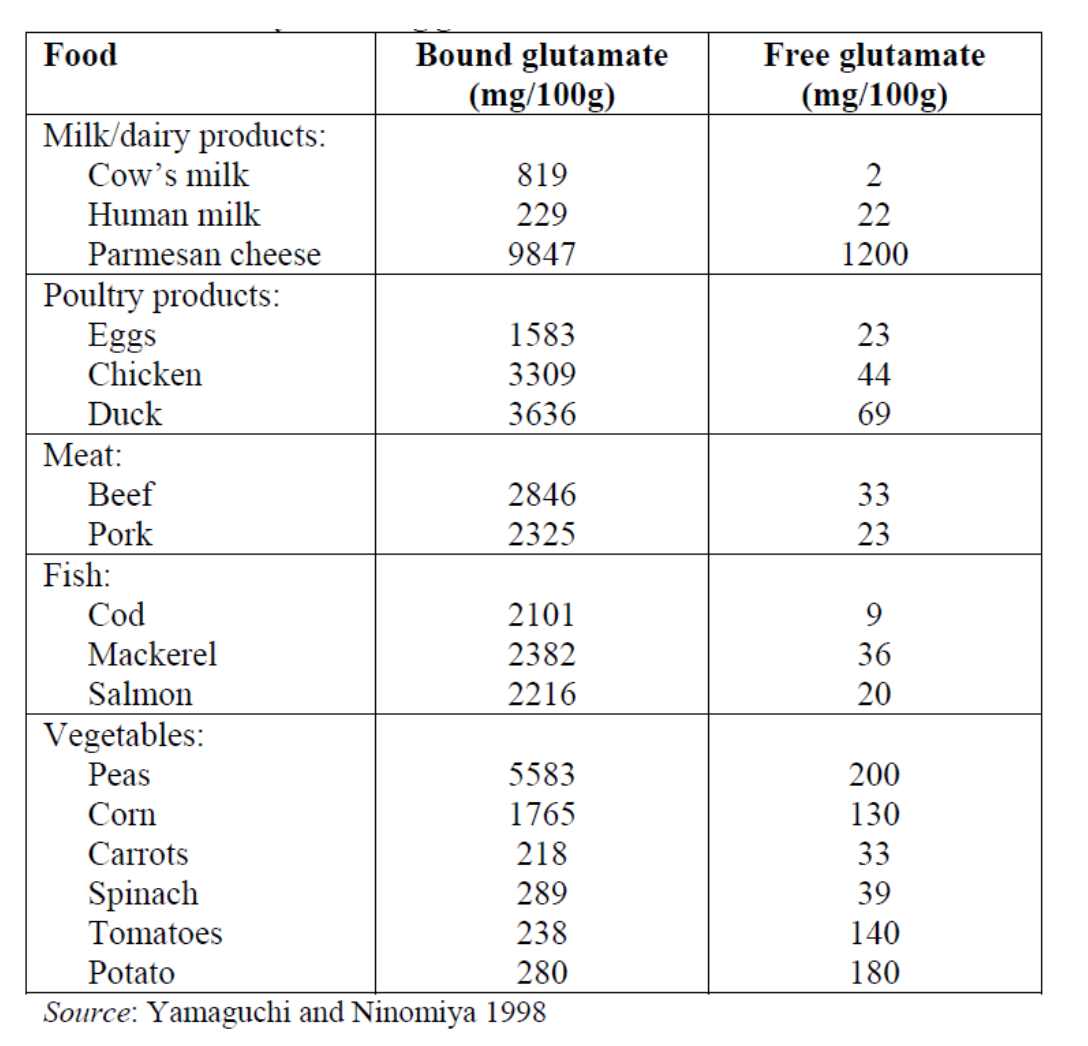
Table 2 – Free glutamate content of traditional seasongings, packaged foods and restaurant meals
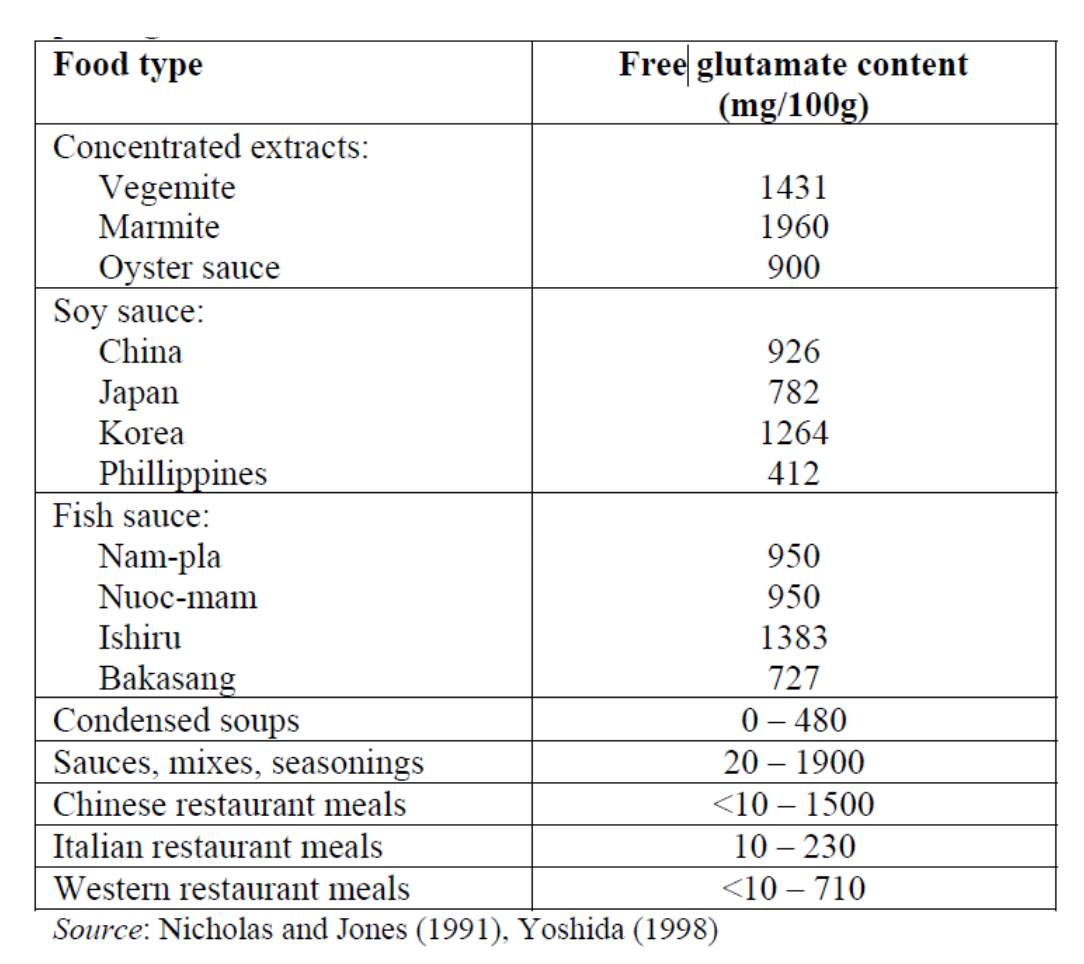
Table 3 - E Number Table
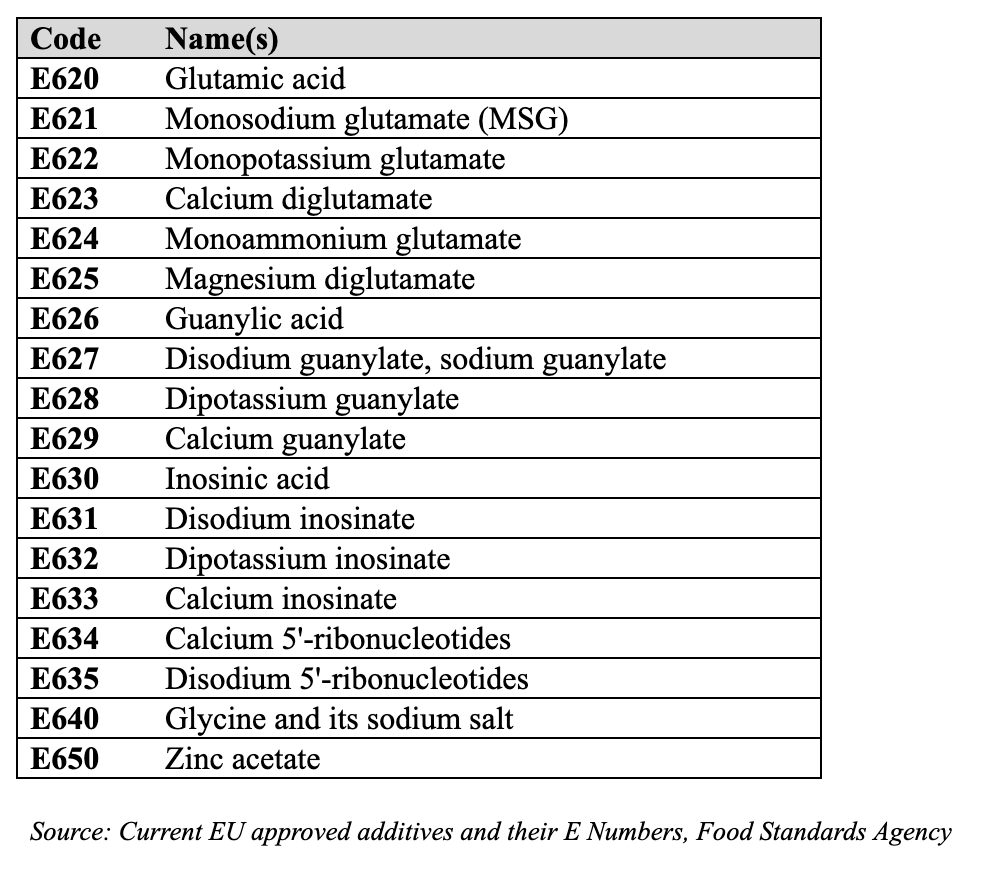
Figure 1 - Free amino acid content in human milk (Lactation stage: 2 Months and above) according to continent of milk collection
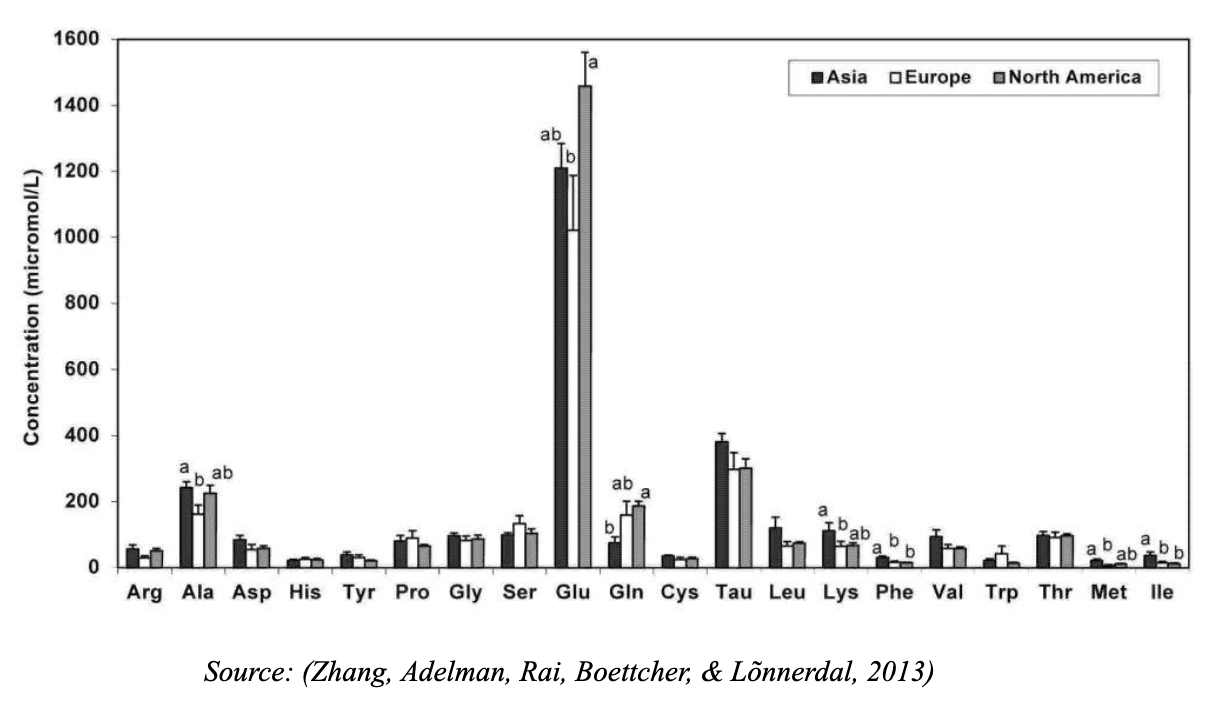
Figure 2 – World consumption of MSG
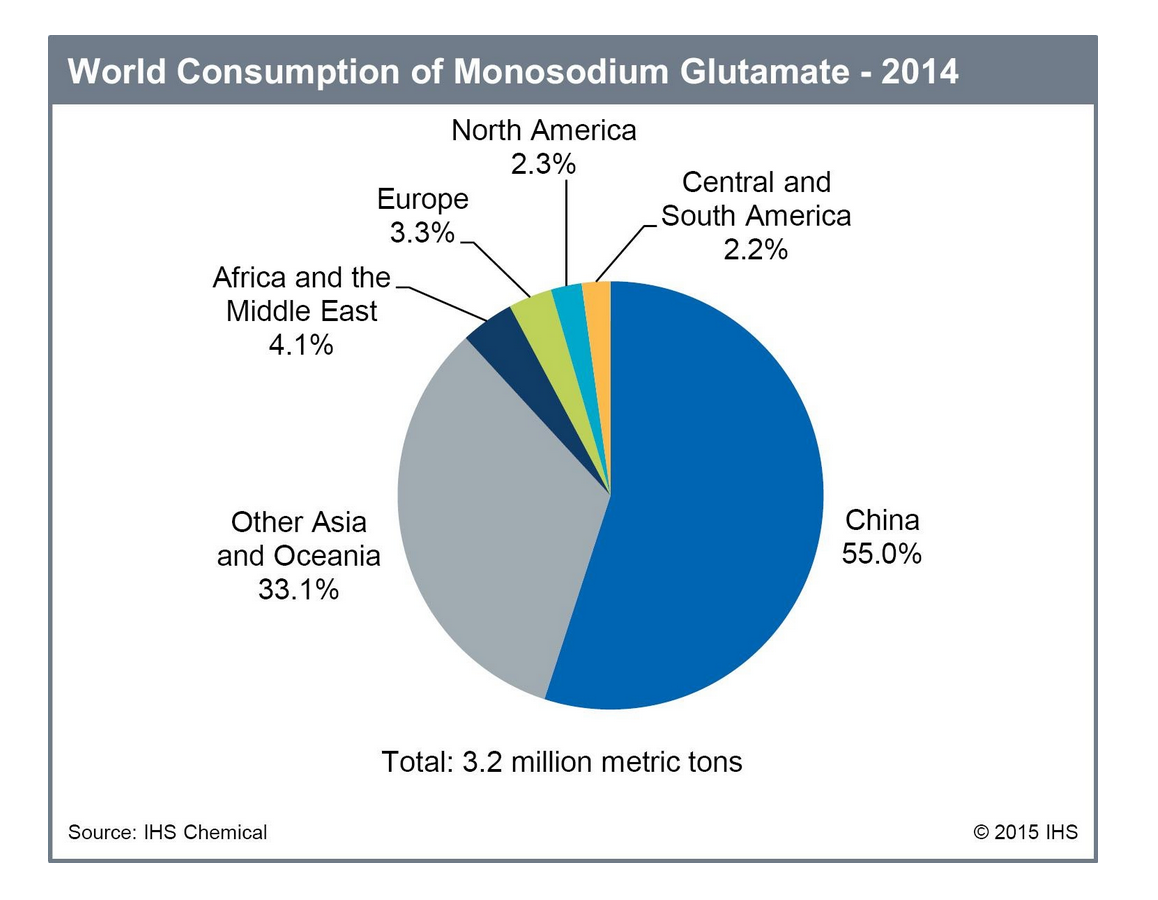
References
- Agostoni, C., Carratù, B., Boniglia, C., Riva, E., & Sanzini, E. (2000, August). Free Amino Acid Content in Standard Infant Formulas: Comparison with Human Milk. Journal of the American College of Nutrition, 19(4), 434-438. doi:10.1080/07315724.2000.10718943
- Beyreuther, K., Biesalski, H. K., Fernstrom, J. D., Grimm, P., Hammes, W. P., Heinemann, U., Walker, R. (2007). Consensus meeting: Monosodium Glutamate – an update. European Journal of Clinical Nutrition, 61, 304-313.
- Food Standards Australia New Zealand. (2003). Sodium Glutamate: A Safety Assessment.
- Haber, B. (2003, February). Life on the Culinary Edge. Retrieved from Harvard Magazine: https://harvardmagazine.com/2003/01/life-on-the-culinary-edg.html
- Hajeb, P., & Jinap, S. (2015). Umami Taste Components and Their Sources in Asian Foods. Critical Reviews in Food Science and Nutrition, 55(6), 778-791. doi:10.1080/10408398.2012.678422
- IHS Markit. (2015). Monosodium Glutamate Report. In IHS Chemical Economics Handbook.
- Kean, S. (2015, October 08). The Science of Satisfaction: A Japanese gourmand discovers the fifth element of taste. Retrieved from The Science History Institute: https://www.sciencehistory.org/distillations/magazine/the-science-of-satisfaction
- Lewicka, P. (2011). Food and Foodways of Medieval Cairenes: Aspects of Life in an Isamlic Metropolis of the Eastern Mediterranean. BRILL.
- Lindermann, B., Ogiwara, Y., & Ninomiya, Y. (2002, November). The Discovery of Umami. Chemical Senses, 27(9), 843-844.
- Sand, J. (2005). A Short History of MSG: Good Science, Bad Science, and Taste Cultures. Gastronomica: The Journal of Critical Food Studies, 5, 38-39. doi:10.1525/gfc.2005.5.4.38
- Sano, C. (2009, September). History of Glutamate Production. The American Journal of Clinical Nutrition, 90, 728-732. doi:10.3945/ajcn.2009.27462F
- Walker, R., & Lupien, J. R. (2000, April). The Safety Evaluation of Monosodium Glutamate. The Journal of Nutrition, 130(4), 1049-1052. doi:10.1093/jn/130.4.1049S
- Yamaguchi, S., & Takahashi, C. (1984, January). Interactions of Monosodium Glutamate and Sodium Chloride on Saltiness and Palatability of a Clear Soup. Journal of Food Science, 49, 82-85. doi:10.1111/j.1365-2621.1984.tb13675.x
- Zhang, Z., Adelman, A. S., Rai, D., Boettcher, J., & Lõnnerdal, B. (2013). Amino Acid Profiles in Term and Preterm Human Milk Through Systematic Review. Nutrients, 5(12), 4800-4821. doi:10.3390/nu5124800
Tharosa Missaka Rajaratne
Undergraduate,
Faculty of Science,
University of Peradeniya
Email : tharosa1942@hotmail.com